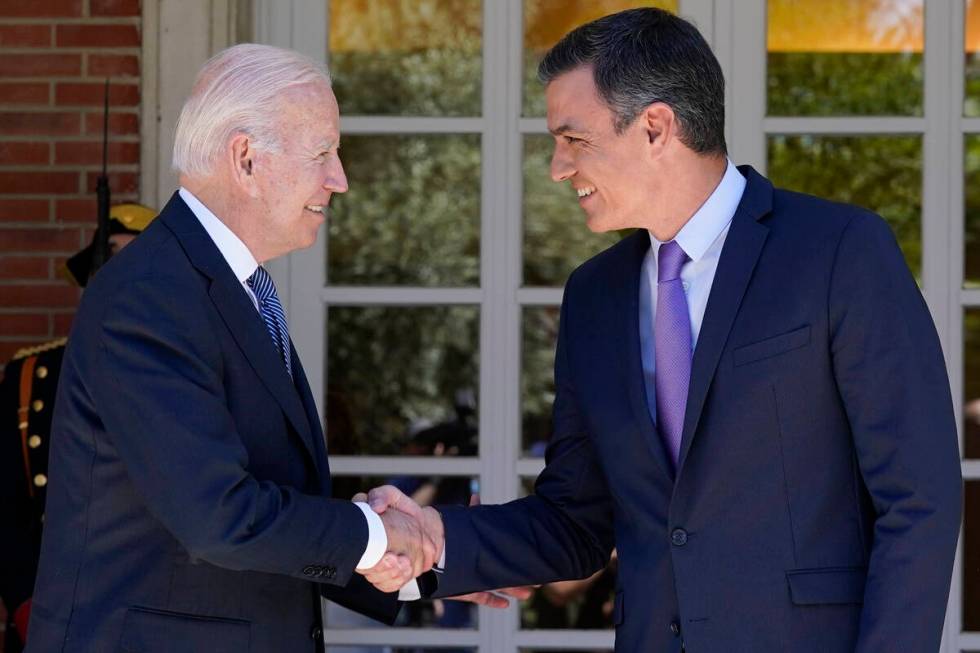Biden arrives at NATO summit looking to buck up weary allies

MADRID — President Joe Biden arrived in Spain on Tuesday to meet with fellow leaders of NATO with plans to beef up the American presence in Europe at a moment of growing concern about the alliance’s resolve in the face of the grinding war in Ukraine.
White House national security adviser Jake Sullivan said that Biden would detail the plan to increase the number of Navy destroyers based in Rota, Spain, from four to six in talks later on Tuesday with Spanish Prime Minister Pedro Sánchez. Sullivan said the move was one of multiple announcements that Biden and NATO allies would make to help bolster the alliance in the region.
Sullivan said the the Rota move “will help increase the United States and NATO’s maritime presence.” He said that Biden would announce additional moves on Wednesday.
“The president said before the war started that if Putin invaded Ukraine, the United States and NATO would enhance the force posture on the eastern flank, not just for the duration of the crisis, but to address the long term change in the strategic reality that that would present,” Sullivan added.
Biden is looking to use this week’s NATO summit to shore up allies amid signs of fractures in the western alliance. After heaping an avalanche of sanctions on the Russian economy and funneling billions of dollars of weaponry into the Ukraine in the face of Russian aggression, NATO partners are showing signs of strain as the cost of energy and other essential goods has skyrocketed.
As the U.S. president departed for the NATO meeting from German Alps, where he first met this week with leaders of the Group of Seven, French President Emmanuel Macron said that the prices are putting European economies in “untenable” situation. Meanwhile, Ukrainian President Volodymyr Zelenskyy, who addressed the G-7 on Monday, has openly worried that the West has become fatigued by the cost of the war.
To be certain, the U.S. has already been building up its presence since shortly before the Russian invasion in late February, adding about 20,000 troops to the 80,000 who were previously in Europe.
Sullivan suggested that other moves Biden is set to announce “will involve additional forces on the eastern flank” of NATO “in a steady state.” He declined to say if some U.S. forces that serve in NATO’s eastern flank on a rotational basis would become permanent.
Biden is set to meet with Turkish President Erdogan Wednesday, as it remains the most vocal holdout to Finland and Sweden joining NATO. The two countries made the historic step of applying for NATO membership in the aftermath of the Russian invasion.
Sullivan said the U.S. does not have a role to play in negotiations between Turkey and the Nordic nations, which are being brokered by NATO Secretary General Stoltenberg.
Turkey wants the two nations to take a tougher line against a Kurdish separatist group it accuses of terrorism. The three countries have been negotiating extensively in Brussels, but analysts have expected that the U.S. might need to play a larger role in bringing Turkey along.
Sullivan said that at the summit, the U.S. would be an advocate for Finland and Sweden joining the alliance and sidestepped the question of whether the U.S. could provide inducements to Turkey for supporting accession of the countries.
Biden will also look to highlight progress made by NATO members at meeting the alliance’s goal of spending 2 percent of gross domestic product on their defense budgets.
Sullivan said a majority of members would report that they have met the benchmark or are on track to by 2024. He described it as a “substantial shift in the intensity and commitment of NATO allies in terms of putting their money where their mouth is.” Biden’s predecessor, Republican Donald Trump, fiercely criticized NATO partners who failed to hit the target.
The president will also hold a rare joint meeting with Japanese Prime Minister Fumio Kishida and South Korean President Yoon Suk Yeol to discuss North Korea’s nuclear program.
U.S. and South Korean officials say that North Korea has all but finished preparations for its first nuclear test since September 2017, when it claimed to have detonated a thermonuclear warhead designed for intercontinental ballistic missiles.
North Korea may use its next nuclear test to claim that it has acquired the ability to build small nuclear warheads that can be placed on short-range missiles or other new weapons systems it has demonstrated in recent months, analysts say.